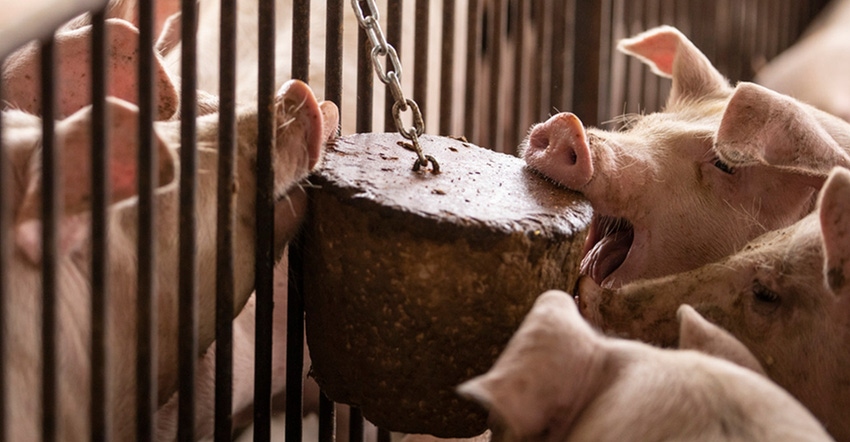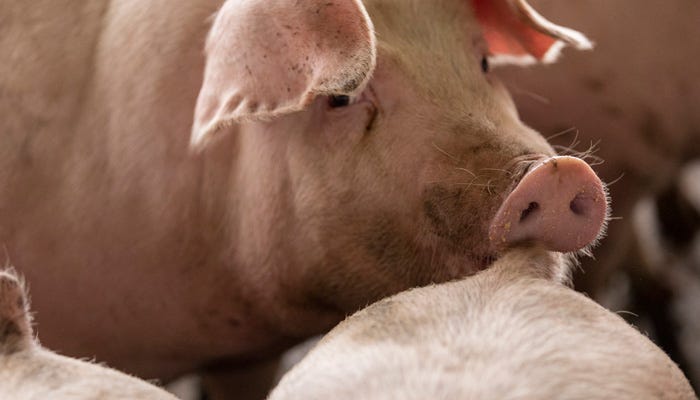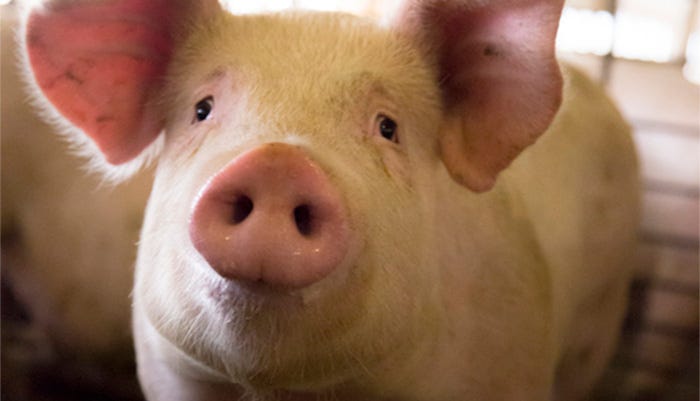Aggressive behavior in pigs — whether it is tail-, flank-, ear- or vulva-biting — is a frustrating management problem, leading to costly losses.
November 6, 2019

Sponsored Content
Aggressive behavior in pigs — whether it is tail-, flank-, ear- or vulva-biting — is a frustrating management problem, leading to costly losses. Tail-biting, in particular, is one of the top behavioral problems in gilt development units and grow-finish pigs that can lead to economic losses due to reductions in gain, secondary infections, death or carcass condemnations.
What are the causes of tail-biting in pigs?
Studies have shown that pigs are attracted to the taste and sight of blood, and if a pig draws blood from accidentally biting a pen-mate’s tail, doing so could elicit the negative behavior in that individual pig or even spread to the entire group of pigs. However, natural behavior is only one piece of the puzzle. Numerous other factors can increase the prevalence of tail-biting, such as environmental stressors (e.g., temperature variation, lighting, ventilation, etc.), dietary issues and health challenges.

Four tips to help reduce and prevent tail-biting
1. Start with the basics: Feed, water, ventilation, temperature and stocking density
Feed: Providing ready access to feed is essential for optimizing average daily gains. Conversely, restriction of or inadequate access to feed will cause slower growth and can contribute to aggressive behavior, such as tail-biting. Feed restriction is most commonly caused by out-of-feed events that are the result of equipment malfunctions, feed bridging or feed management errors. The second-most common cause of feed restriction is feeder settings being adjusted too tightly.
Water: Just as with feed, it is important to provide ready access to drinking water. Restricting the water intake of pigs can lead to reduced feed intakes and may also contribute to aggressive behavior. Make sure all of the pigs have enough water access points and that the flow rate is adequate enough to meet their water needs.
Ventilation: Poor ventilation, especially in the late-fall and winter months, can quickly induce aggressive behaviors. Make sure the ventilation is adequate enough to at least remove pit gasses from your facility. Poor air quality in barns irritates animals and is a major catalyst accelerating aggression in pigs.
Temperature: In warmer months, heat stress is of great concern and is something that barn managers and employees should keep an eye on. When pigs reach their upper critical temperature, they begin to experience heat stress, which can trigger negative behaviors, such as tail-biting.
Stocking density: Overstocking induces extra stress in animals due to the increased competition for feed and water resources in the pen. As such, it is critically important to relieve stocking density by evenly marketing pigs throughout all of the pens. Limited space in pens is a common trigger for tail-biting.
2. Provide balanced nutrition
Nutritional imbalances or improperly balanced diets are contributing factors that can increase the likelihood of aggressive behavior. Under-budgeting and/or under-formulating lysine for high lean growth genetics can lead to vice behavior by restricting the genetic growth potential of the animal. Inadequate sodium in the diet can also lead to aggressive behavior.
3. Look for signs of health challenges
Significant viral challenges, like porcine reproductive and respiratory syndrome and the flu, can lead to increased incidences of aggressive behavior in pigs. Consult your veterinarian on the best course of action to relieve any health challenges in your operation.
4. Keep calm and entertain
Pigs are naturally very curious animals that utilize their mouths as a means of exploring and learning more about their environment. As such, providing enrichment that is stimulating and that biologically relieves stress is crucial.
The AllBite block, from Hubbard Feeds and Alltech, is a molasses-based block designed to discourage tail-biting and other aggressive vice behaviors. AllBite adds a new stimulus to the pigs’ environment, thus allowing pigs to exhibit foraging behaviors and to bite and chew on the block instead of their pen-mates.

AllBite combats aggressive behavior through two mechanisms: it contains biologically active calming agents that reduce stress within the pen, and it is delivered in a form that provides a sensory stimulus to a group of pigs. Researched and tested in the field, AllBite has a 93% success rate in reducing or stopping tail-biting. The key is early identification, followed by the introduction of AllBite into pens where tail-biting and other aggressive behaviors are occurring.
While changing diets to mitigate negative behaviors is a common practice, dietary changes are often not implemented early enough to effectively prevent those negative behaviors from manifesting. Also, most vice behaviors only affect a small group within a larger population, so changing diets can sometimes become costly. With its unique delivery system, AllBite addresses both issues, since blocks can be placed in pens as soon as tail-biting occurs, and the blocks are only supplemented in the pens where pigs are exhibiting vice behaviors.
During a tail-biting outbreak, it is important to try and identify the biters and treat and/or remove the bitten pigs to prevent the behavior from spreading to other pigs. The root of vice and aggressive behavior is multi-factorial, and the mechanisms of this behavior are not fully understood. However, a quick response is key to helping prevent or stop vice behaviors in pigs. Tail-biting is a universal concern, and, as animal caretakers, maintaining the welfare
You May Also Like



